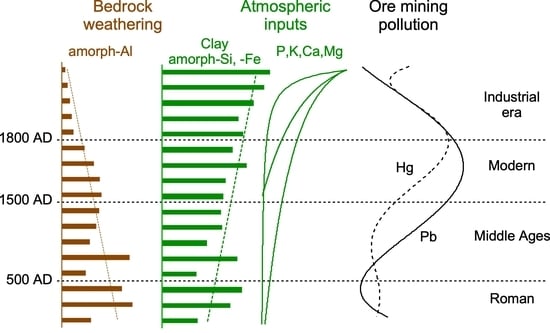Geochemistry and Sedimentology of a Minerotrophic Peat in a Western Mediterranean Mountain Wilderness Area
Abstract
Highlights
- The peat age was late Holocene, and less than 1900 years old.
- The peat contained no charcoal, probably due to the lack of woody cover at the site for 1900 years.
- Depth profiles of clay and nutrients (P, K, Ca, Mg) revealed an increase in atmospheric inputs over time, while nitrogen is homogeneously sequestrated in depth.
- The dominant metallic trace elements (MTE) were cadmium, which peaked during the Roman epoch, then lead and mercury concentrated during the modern period, but decreasing onwards.
- Peat geochemistry is strongly influenced by local and regional human activities, revealing a peat modified by social imprints.
Abstract
1. Introduction
2. Materials and Methods
2.1. Study Site
2.2. Peat Sampling and Dating
2.3. Charcoal Counting for Fire Analyses
2.4. Granulometry and Geochemical Analyses
3. Results
3.1. Sediment Profile and Chronology
3.2. Granulometry, Organic Matter and Charcoal
3.3. Geochemistry
4. Discussion
4.1. Absence of Charcoal: No Wildfire Because of a Lack of Woody Cover
4.2. A Late Inception of Peat Accumulation
4.3. Local Processes Became Less Significant over time while Regional Influences Increased
4.4. Metal Trace Elements (MTE) Deposition
5. Conclusions
Author Contributions
Funding
Acknowledgments
Conflicts of Interest
References
- Loÿe-Pilot, M.D.; Martin, J.M.; Morelli, J. Influence of Saharan dust on the rain acidity and atmospheric input to the Mediterranean. Nature 1986, 321, 427–428. [Google Scholar] [CrossRef]
- Cortizas, A.M.; López-Costas, O.; Orme, L.; Mighall, T.; Kylander, M.E.; Bindler, R.; Sala, G. Holocene atmospheric dust deposition in NW Spain. Holocene 2019, 30, 507–518. [Google Scholar] [CrossRef]
- Mourier, B.; Poulenard, J.; Chauvel, C.; Faivre, P.; Carcaillet, C. Distinguishing subalpine soil types using extractible Al and Fe fractions and REE geochemistry. Geoderma 2008, 145, 107–120. [Google Scholar] [CrossRef]
- Renberg, I.; Persson, M.W.; Emteryd, O. Pre-industrial atmospheric lead contamination detected in Swedish lake sediments. Nature 1994, 368, 323–326. [Google Scholar] [CrossRef]
- Shotyk, W.; Cheburkin, A.K.; Appleby, P.G.; Fankhauser, A.; Kramers, J.D. Two thousand years of atmospheric arsenic, antimony, and lead deposition recorded in an ombrotrophic peat bog profile, Jura Mountains, Switzerland. Earth Planet. Sci. Lett. 1996, 145, E1–E7. [Google Scholar] [CrossRef]
- Rausch, N.; Nieminen, T.; Ukonmaanaho, L.; Le Roux, G.; Krachler, M.; Cheburkin, A.K.; Bonani, G.; Shotyk, W. Comparison of Atmospheric Deposition of Copper, Nickel, Cobalt, Zinc, and Cadmium Recorded by Finnish Peat Cores with Monitoring Data and Emission Records. Environ. Sci. Technol. 2005, 39, 5989–5998. [Google Scholar] [CrossRef]
- Allan, M.; Le Roux, G.; De Vleeschouwer, F.; Bindler, R.; Blaauw, M.; Piotrowska, N.; Sikorski, J.; Fagel, N. High-resolution reconstruction of atmospheric deposition of trace metals and metalloids since AD 1400 recorded by ombrotrophic peat cores in Hautes-Fagnes, Belgium. Environ. Pollut. 2013, 178, 381–394. [Google Scholar] [CrossRef]
- Loye-Pilot, M.D.; Morelli, J. Flucturations of ionic composition of precipitations collected in Corsica related to changes in the origins of incoming aerosols. J. Aerosol. Sci. 1988, 19, 577–585. [Google Scholar] [CrossRef]
- Carcaillet, C.; Bouvier, M.; Fréchette, B.; Larouche, A.C.; Richard, P.J. Comparison of pollen-slide and sieving methods in lacustrine charcoal analyses for local and regional fire history. Holocene 2001, 11, 467–476. [Google Scholar] [CrossRef]
- Clark, J.S.; Lynch, J.; Stocks, B.J.; Goldammer, J.G. Relationships between charcoal particles in air and sediments in west-central Siberia. Holocene 1998, 8, 19–29. [Google Scholar] [CrossRef]
- Ohlson, M.; Tryterud, E. Interpretation of the charcoal record in forest soils: forest fires and their production and deposition of macroscopic charcoal. Holocene 2000, 10, 519–525. [Google Scholar] [CrossRef]
- Lynch, J.A.; Clark, J.S.; Stocks, B.J. Charcoal production, dispersal, and deposition from the Fort Providence experimental fire: interpreting fire regimes from charcoal records in boreal forests. Can. J. For. Res. 2004, 34, 1642–1656. [Google Scholar] [CrossRef]
- Brun, J.-P.; Laubenheimer, F. Conclusion. Gallia 2001, 58, 203–219. [Google Scholar] [CrossRef]
- Laubenheimer, F. (Ed.) 20 ans de Recherches à Sallèle d’Aude; Institut des Sciences et Techniques de l’Antiquité (Collection ISTA, 760), Presses Universitaires Franc-Comtoises: Besançon, France, 2001; p. 302. [Google Scholar]
- Decombeix, P.M.; Domergue, C.; Fabre, J.-M.; Gorgues, A.; Rico, C.; Tollon, F.; Tournier, B. Réflexions sur l'organisation de la production de fer à l'époque romaine dans le bassin supérieur de la Dure, au voisinage des Martys (Aude). Gallia 2002, 57, 23–36. [Google Scholar] [CrossRef]
- Beyrie, A.; Fabre, J.M.; Kammenthaler, E.; Mantenant, J.; Munteanu, G.; Rico, C. Une vaste exploitation minière du second Âge du fer. La mine de cuivre des Barrencs (Lastours, Fournes-Cabardès, Aude). Rev. Archéologique De La Narbonn. 2011, 44, 39–55. [Google Scholar] [CrossRef]
- Baron, S.; Carignan, J.; Laurent, S.; Ploquin, A. Medieval lead making on Mont-Lozère Massif (Cévennes-France): Tracing ore sources using Pb isotopes. Appl. Geochem. 2006, 21, 241–252. [Google Scholar] [CrossRef]
- Enrico, M.; Le Roux, G.; Heimbürger, L.-E.; Van Beek, P.; Souhaut, M.; Chmeleff, J.; Sonke, J.E. Holocene Atmospheric Mercury Levels Reconstructed from Peat Bog Mercury Stable Isotopes. Environ. Sci. Technol. 2017, 51, 5899–5906. [Google Scholar] [CrossRef]
- Martinez-Cortizas, A.; Pontevedra Pombal, X.; Novoa Munoz, J.C.; Garcia-Rodeja, E. Four thousand years of atmospheric Pb, Ca and Zn deposition recorded by the ombrotrophic peat bog of Penido Vello (Northwestern Spain). Water Air Soil Pollut. 1997, 100, 387–403. [Google Scholar] [CrossRef]
- Pontevedra-Pombal, X.; Mighall, T.M.; Nóvoa-Muñoz, J.C.; Peiteado-Varela, E.; Rodríguez-Racedo, J.; García-Rodeja, E.; Martínez-Cortizas, A. Five thousand years of atmospheric Ni, Zn, As, and Cd deposition recorded in bogs from NW Iberia: prehistoric and historic anthropogenic contributions. J. Archaeol. Sci. 2013, 40, 764–777. [Google Scholar] [CrossRef]
- Bindler, R.; Rydberg, J.; Renberg, I. Establishing natural sediment reference conditions for metals and the legacy of long-range and local pollution on lakes in Europe. J. Paleolimnol. 2010, 45, 519–531. [Google Scholar] [CrossRef]
- Mariet, A.-L.; Monna, F.; Gimbert, F.; Bégeot, C.; Cloquet, C.; Belle, S.; Millet, L.; Rius, D.; Walter-Simonnet, A.-V. Tracking past mining activity using trace metals, lead isotopes and compositional data analysis of a sediment core from Longemer Lake, Vosges Mountains, France. J. Paleolimnol. 2018, 60, 399–412. [Google Scholar] [CrossRef]
- Carcaillet, C.; Perroux, A.-S.; Genries, A.; Perrette, Y. Sedimentary charcoal pattern in a karstic underground lake, Vercors massif, French Alps: implications for palaeo-fire history. Holocene 2007, 17, 845–850. [Google Scholar] [CrossRef]
- Vives, G.S.; Miras, Y.; Riera, S.; Julià, R.; Allée, P.; Orengo, H.; Paradis-Grenouillet, S.; Palet, J.M. Tracing the land use history and vegetation dynamics in the Mont Lozère (Massif Central, France) during the last 2000 years: The interdisciplinary study case of Countrasts peat bog. Quat. Int. 2014, 353, 123–139. [Google Scholar] [CrossRef]
- Pontevedra-Pombal, X.; Castro, D.; Carballeira, R.; Souto, M.; López-Sáez, J.; Pérez-Díaz, S.; Fraga, M.; Valcárcel, M.; García-Rodeja, E. Iberian Acid Peatlands: Types, Origin and General Trends of Development. 2017, pp. 1–19. Available online: https://digital.csic.es/bitstream/10261/199953/4/iberian_acid_peatlands.pdf (accessed on 18 August 2022).
- Stuiver, M.; Reimer, P.J. Extended 14C data base and revised CALIB 3.0 14C age calibration program. Radiocarbon 1993, 35, 215–230. [Google Scholar] [CrossRef]
- Reimer, P.J.; Austin, W.E.N.; Bard, E.; Bayliss, A.; Blackwell, P.G.; Ramsey, C.B.; Butzin, M.; Cheng, H.; Edwards, R.L.; Friedrich, M.; et al. The IntCal20 Northern Hemisphere Radiocarbon Age Calibration Curve (0–55 cal kBP). Radiocarbon 2020, 62, 725–757. [Google Scholar] [CrossRef]
- Blaauw, M.; Christen, J.A. Flexible paleoclimate age-depth models using an autoregressive gamma process. Bayesian Anal. 2011, 6, 457–474. [Google Scholar] [CrossRef]
- Bottollier-Curtet, M.; Muller, S. Dynamique et context passes du développement d’une tourbière méditerranéenne (Massif de l’Aigoual, France). C. R. Biol. 2009, 332, 69–82. [Google Scholar] [CrossRef]
- Power, M.J.; Marlon, J.; Ortiz, N.; Bartlein, P.J.; Harrison, S.P.; Mayle, F.E.; Ballouche, A.; Bradshaw, R.H.W.; Carcaillet, C.; Cordova, C.; et al. Changes in fire regimes since the Last Glacial Maximum: an assessment based on a global synthesis and analysis of charcoal data. Clim. Dyn. 2007, 30, 887–907. [Google Scholar] [CrossRef]
- Pausas, J.G.; Fernández-Muñoz, S. Fire regime changes in the Western Mediterranean Basin: from fuel-limited to drought-driven fire regime. Clim. Chang. 2011, 110, 215–226. [Google Scholar] [CrossRef]
- Fréjaville, T.; Curt, T.; Carcaillet, C. Tree cover and seasonal precipitation drive understorey flammability in alpine mountain forests. J. Biogeogr. 2016, 43, 1869–1880. [Google Scholar] [CrossRef]
- Trouet, V.; Panayotov, M.; Ivanova, A.; Frank, D. A pan-European summer teleconnection mode recorded by a new temperature reconstruction from the northeastern Mediterranean (ad 1768–2008). Holocene 2012, 22, 887–898. [Google Scholar] [CrossRef]
- Genries, A.; Muller, S.D.; Mercier, L.; Bircker, L.; Carcaillet, C. Fires control spatial variability of subalpine vegetation dynamics during the Holocene in the Maurienne valley (French Alps). Écoscience 2009, 16, 13–22. [Google Scholar] [CrossRef]
- Oris, F.; Lamentowicz, M.; Genries, A.; Mourier, B.; Blarquez, O.; Ali, A.A.; Bremond, L.; Carcaillet, C.; Mariusz, L. Holocene changes in climate and land use drove shifts in the diversity of testate amoebae in a subalpine pond. J. Paleolimnol. 2013, 49, 633–646. [Google Scholar] [CrossRef]
- Bal, M.C.; Allée, P.; Liard, M. Charcoal from soil: The origin of Nardus stricta grassland and the history of a mountain cultural landscape (Mont Lozère, France) since the Neolithic period. Quat. Int. 2015, 366, 3–14. [Google Scholar] [CrossRef]
- Vernet, J.-L. History of the Pinus sylvestris and Pinus nigra ssp. salzmanni forest in the Sub-Mediterranean mountains (Grands Causses, Saint-Guilhem-le-Désert, southern Massif Central, France) based on charcoal from limestone and dolomitic deposits. Veg. Hist. Archaeobotany 2006, 16, 23–42. [Google Scholar] [CrossRef]
- Coûteaux, M. Recherches pollenanalytiques en Oisans: Le plateau de Brande (Alpe d’Huez, Isere, France). Bull. Soc. R. Bot. Belgique 1982, 115, 91–106. [Google Scholar]
- Cubizolle, H.; Tourman, A.; Argant, J.; Porteret, J.; Oberlin, C.; Serieyssol, K. Origins or European biodiversity: paleo-geographic signification of peat inception during the Holocene in. the granitic eastern Massiff Central (France). Landsc. Ecol. 2003, 18, 227–238. [Google Scholar] [CrossRef]
- Cubizolle, H.; Fassion, F.; Argant, J.; Latour-Argant, C.; Galet, P.; Oberlin, C. Mire initiation, climatic change and agricultural expansion over the course of the Late-Holocene in the Massif Central mountain range (France): causal links and implication for mire conservation. Quat. Intern. 2012, 251, 77–96. [Google Scholar] [CrossRef]
- Frenzel, B. L’Homme comme facteur géologique en Europe. Bull. Asso. Française Etude Quat. 1979, 16, 191–199. [Google Scholar] [CrossRef]
- Fletcher, M.-S.; Wood, S.W.; Haberle, S.G. A fire-driven shift from forest to non-forest: evidence for alternative stable states? Ecology 2014, 95, 2504–2513. [Google Scholar] [CrossRef]
- Lüning, S.; Schulte, L.; Garcés-Pastor, S.; Danladi, I.; Gałka, M. The Medieval Climate Anomaly in the Mediterranean Region. Paleoceanogr. Paleoclimatol. 2019, 34, 1625–1649. [Google Scholar] [CrossRef]
- Cisneros, M.; Cacho, I.; Moreno, A.; Stoll, H.; Torner, J.; Català, A.; Edwards, R.L.; Cheng, H.; Fornós, J.J. Hydroclimate variability during the last 2700 years based on stalagmite multi-proxy records in the central-western Mediterranean. Quat. Sci. Rev. 2021, 269, 107137. [Google Scholar] [CrossRef]
- Klančnik, K.; Vogel-Mikuš, K.; Gaberščik, A. Silicified structures affect leaf optical properties in grasses and sedge. J. Photochem. Photobiol. B Biol. 2014, 130, 1–10. [Google Scholar] [CrossRef]
- Weiss, D.; Shotyk, W.; Cheburkin, A.K.; Gloor, M.; Reese, S. Atmospheric Lead Deposition from 12,400 to ca. 2000 yrs BP in a Peat Bog Profile, Jura Mountains, Switzerland. Water Air Soil Pollut. 1997, 100, 311–324. [Google Scholar] [CrossRef]
- Verhoeven, J.T.A. Nutrient dynamics in minerotrophic peat mires. Aquat. Bot. 1986, 25, 117–137. [Google Scholar] [CrossRef]
- Carozza, L.; Georjon, C. La fin du Néolithique et les débuts de la métallurgie en Languedoc central: contrôle social du territoire et pratiques économiques entre 3200 et 2400 av. J.-C. dans la moyenne vallée de l’Hérault. Rev. Archéologique De L’est 2006, 25, 215–237. [Google Scholar]
- Marlon, J.R.; Bartlein, P.J.; Daniau, A.-L.; Harrison, S.P.; Maezumi, S.Y.; Power, M.J.; Tinner, W.; Vanniére, B. Global biomass burning: A synthesis and review of Holocene paleofire records and their controls. Quat. Sci. Rev. 2013, 65, 5–25. [Google Scholar] [CrossRef]
- Marlon, J.; Bartlein, P.; Carcaillet, C.; Gavin, D.; Harrison, S.; Higuera, P.; Joos, F.; Power, M.J.; Prentice, I.C. Climate and human influences on global biomass burning over the past two millennia. Nat. Geosci. 2008, 1, 697–702. [Google Scholar] [CrossRef]
- Talbot, J.; Moore, T.R.; Wang, M.; Dallaire, C.O.; Riley, J.L. Distribution of lead and mercury in Ontario peatlands. Environ. Pollut. 2017, 231, 890–898. [Google Scholar] [CrossRef]
- Allan, M.; Le Roux, G.; Sonke, J.E.; Piotrowska, N.; Streel, M.; Fagel, N. Reconstructing historical atmospheric mercury deposition in Western Europe using: Misten peat bog cores, Belgium. Sci. Total Environ. 2013, 442, 290–301. [Google Scholar] [CrossRef]
- Fabre, L. Le Charbonnage Historique de la Chênaie à Quercus Ilex L. (Languedoc, France): Conséquences Écologiques. Ph.D. Thesis, University of Montpellier 2, Montpellier, France, 1996. [Google Scholar]
- Allée, P.H.; Paradis, S.; Boumedienne, F. La forêt médiévale charbonnée du Mont Lozère: de la paléométallurgie à l’archéologie forestière. Archéosciences 2010, 34, 177e186. [Google Scholar]
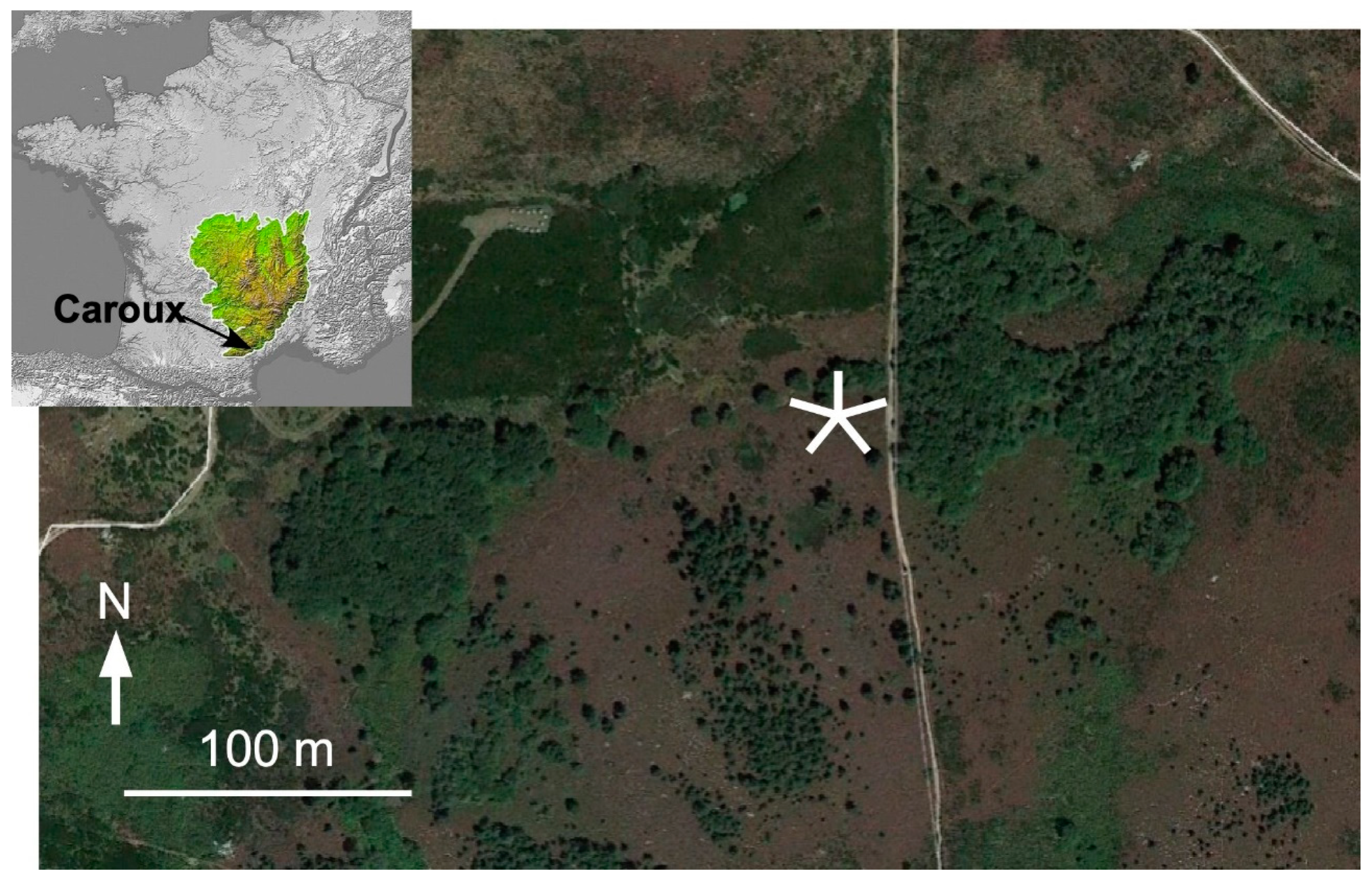
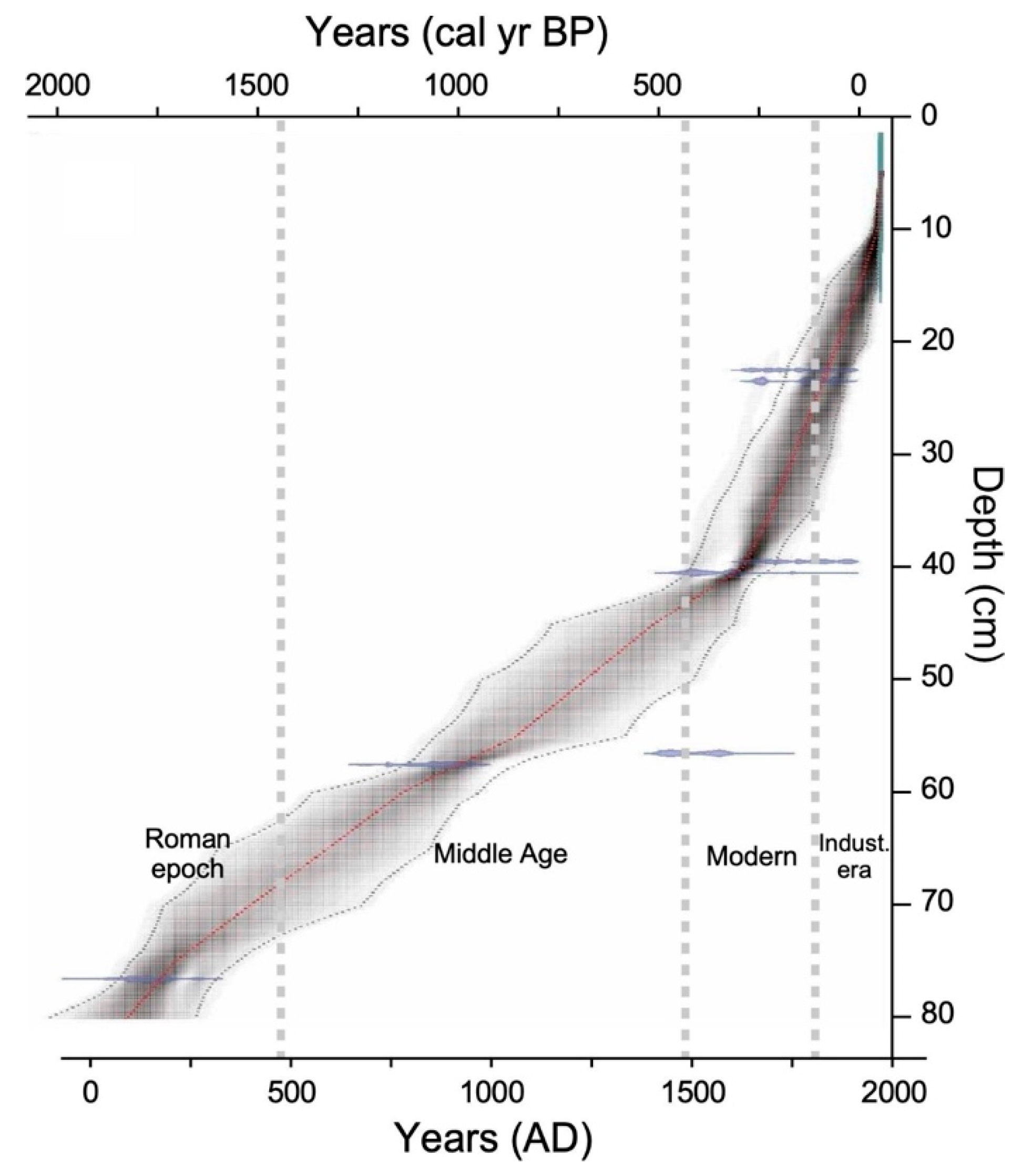

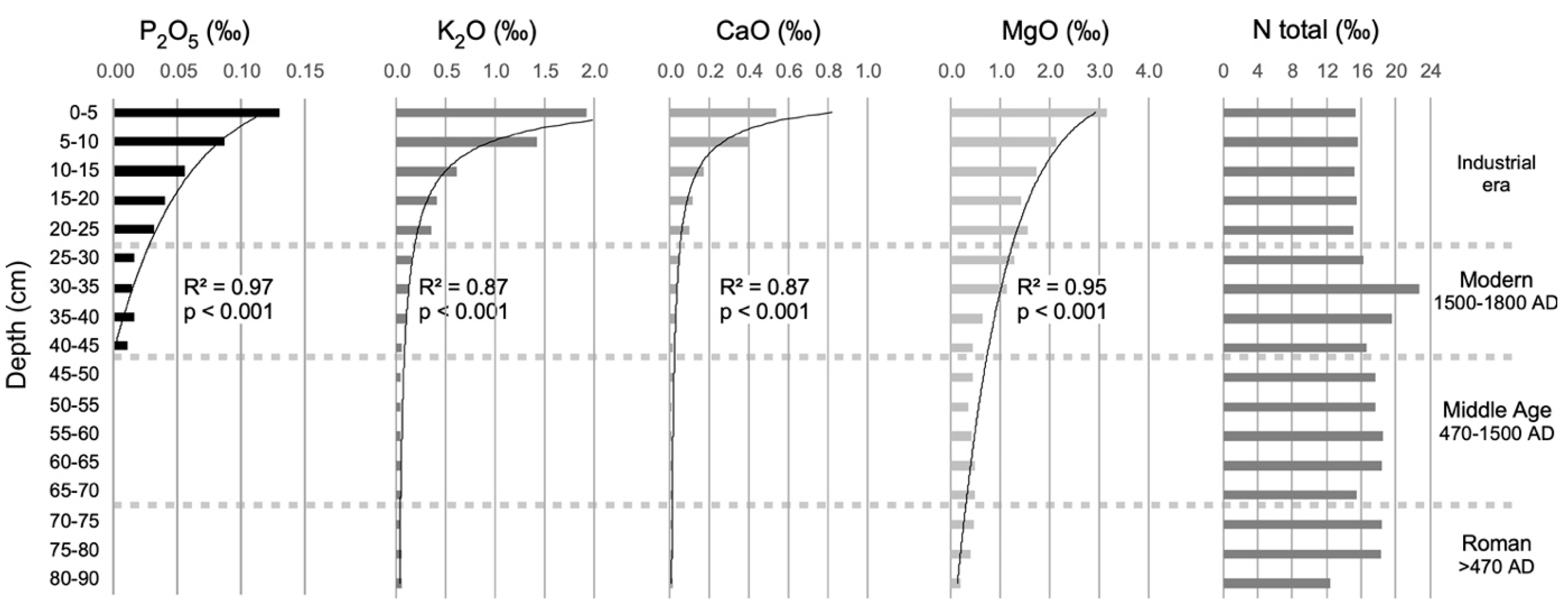

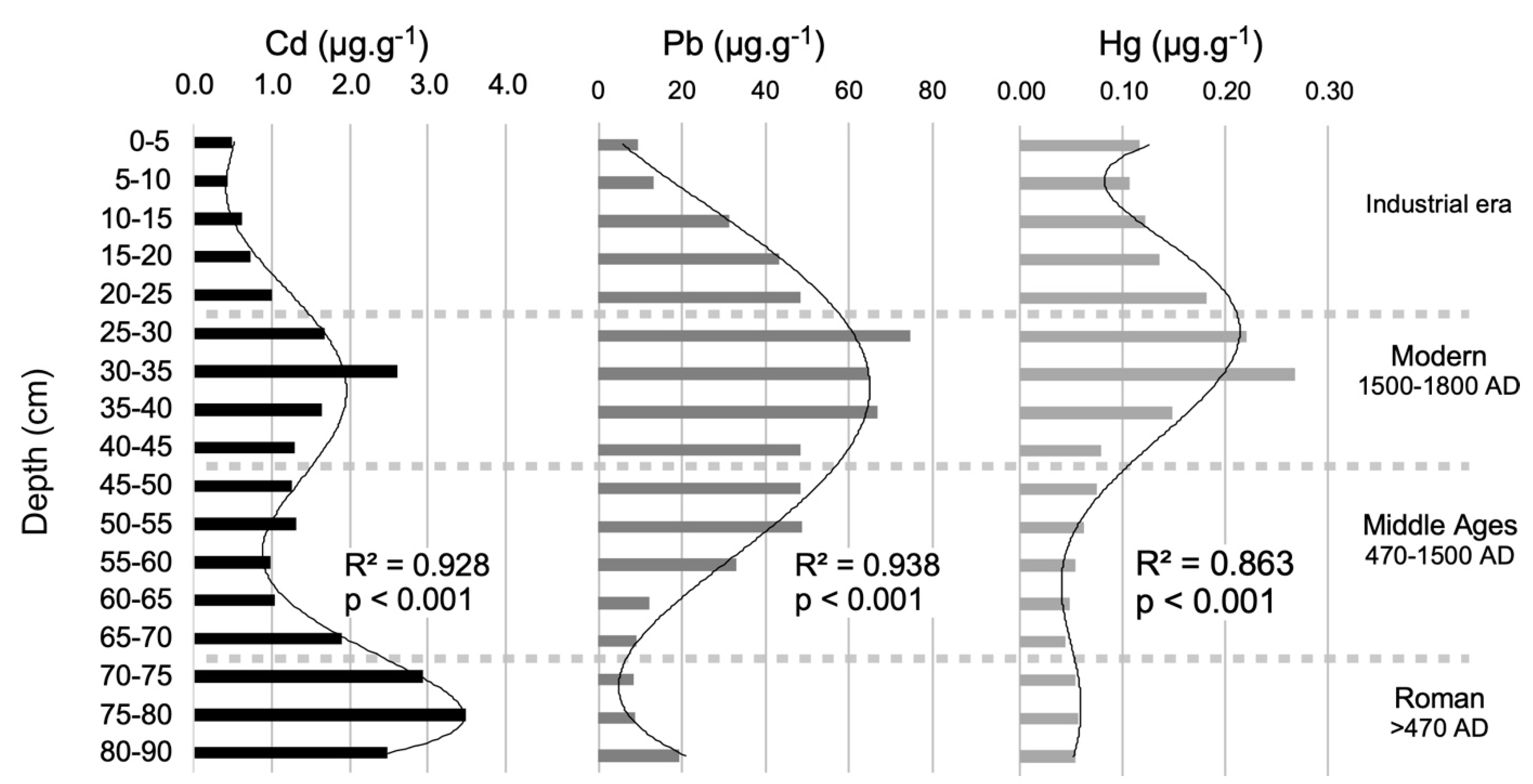
| Depth (cm) | Lab. Code | Dated Dry Mass (mg) | Corrected Fraction of pMC | 14C Years | Calendar Years | Median Probability |
|---|---|---|---|---|---|---|
| 15–16 | SacA 16532 | 577 | 140.15 ± 0.36 | n/a | Modern | n/a |
| 16–17 | SacA 16533 | 332 | 151.90 ± 0.30 | n/a | Modern | n/a |
| 32–33 | SacA 16534 | 299 | 98.21 ± 0.25 | 145 ± 30 BP | 1669–1947 AD | 1812 AD |
| 33–34 | SacA 16535 | 390 | 99.38 ± 0.24 | 50 ± 30 BP | modern | |
| 49–50 | SacA 16536 | 491 | 98.21 ± 0.24 | 145 ± 30 BP | 1669–1947 AD | 1812 AD |
| 50–51 | SacA 16537 | 753 | 96.44 ± 0.26 | 290 ± 30 BP | 1498–1792 AD | 1565 AD |
| 66–67 | SacA 16538 | 667 | 95.50 ± 0.24 | 370 ± 30 BP | 1451–1633 AD | 1518 AD |
| 67–68 | SacA 16539 | 554 | 86.84 ± 0.23 | 1135 ± 30 BP | 775–992 AD | 926 AD |
| 86–87 | SacA 16540 | 2423 | 79.31 ± 0.22 | 1860 ± 30 BP | 86–243 AD | 179 AD |
Publisher’s Note: MDPI stays neutral with regard to jurisdictional claims in published maps and institutional affiliations. |
© 2022 by the authors. Licensee MDPI, Basel, Switzerland. This article is an open access article distributed under the terms and conditions of the Creative Commons Attribution (CC BY) license (https://creativecommons.org/licenses/by/4.0/).
Share and Cite
Goutiers, V.; Carcaillet, C. Geochemistry and Sedimentology of a Minerotrophic Peat in a Western Mediterranean Mountain Wilderness Area. Quaternary 2022, 5, 48. https://doi.org/10.3390/quat5040048
Goutiers V, Carcaillet C. Geochemistry and Sedimentology of a Minerotrophic Peat in a Western Mediterranean Mountain Wilderness Area. Quaternary. 2022; 5(4):48. https://doi.org/10.3390/quat5040048
Chicago/Turabian StyleGoutiers, Vladimir, and Christopher Carcaillet. 2022. "Geochemistry and Sedimentology of a Minerotrophic Peat in a Western Mediterranean Mountain Wilderness Area" Quaternary 5, no. 4: 48. https://doi.org/10.3390/quat5040048
APA StyleGoutiers, V., & Carcaillet, C. (2022). Geochemistry and Sedimentology of a Minerotrophic Peat in a Western Mediterranean Mountain Wilderness Area. Quaternary, 5(4), 48. https://doi.org/10.3390/quat5040048



